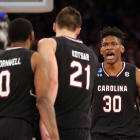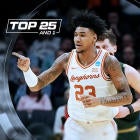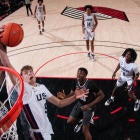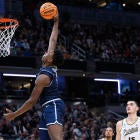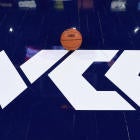South Carolina’s spurt to the Final Four can be qualified as Cinderella. Why is that, even if the Gamecocks come from the SEC? I’m about to show you. Since the expansion of the NCAA Tournament in 1985, to 64 teams, the Final Four has occasionally been blessed with a party crasher.
The Gamecocks aren’t the greatest, but they are the latest, and in looking at some of the biggest national-semifinal shockers over the years, their run has to be near the top.
How many teams made the Final Four after not garnering a single vote in the preseason AP Top 25 poll -- then closed out the regular season in the same situation? Not many. But South Carolina qualifies.
Here’s how the Gamecocks’ charmed run compares to the other all-time stunners since 1985, i.e. the modern tournament era.
10. 1985 Villanova (No. 8 seed)
The ’85 Wildcats are one of the most memorable champions in tournament history thanks to their upset of Patrick Ewing and Georgetown. But VU’s run to Lexington that season (Rupp Arena hosted the Final Four in 1985; it was a simpler time) wasn’t an out-and-out shock. Remember, Villanova was a part of the Big East during that league’s apex. The Wildcats weren’t the best team or program in the league, but they weren’t also-rans, either. Nova spent many weeks in the top 25 polls in the 1984-85 season, making its first showing the week of Jan. 8. It sneaked into the field after sputtering down the stretch. Similar to South Carolina losing six of its final nine before the NCAAs, that Villanova team was 4-5.
The Wildcats had a loaded team. Back then, the NBA Draft had more than two rounds. Six VU players were eventually drafted, Ed Pinckney the most famous of them, but Harold Pressley (first round) and Dwayne McClain (second) were also notable picks. Villanova’s road to that Final Four included a 51-49 win over Dayton in the first round, then the 59-55 upset of top-seeded Michigan, which had just barely gotten by Fairleigh Dickinson with a 59-55 win of its own two days before.
Villanova had another close-call win in the Sweet 16, this time over No. 5 Maryland, which needed OT to get past Miami University in the first round, then edged No. 13 Navy by five points in the second round (and probably only happened because David Robinson didn’t score a point in the final 12 minutes of that game). Villanova’s dominant Elite Eight win over No. 2 North Carolina is the highlight. Rollie Massimino’s team wins 56-44, completing a four-game stretch wherein VU made it to the national semifinals while averaging 53 points. Wild.
9. 2016 Syracuse (No. 10 seed)
OK, the fact this in No. 9 shows how good the list is going to be. Syracuse was 19-13 heading into the NCAA Tournament. Many believed the Orange didn’t even deserve a spot in the field, yet SU dodged the First Four. Jim Boeheim’s team had three future NBA picks on that squad: Malachi Richardson went in the first round of the 2016 NBA Draft, and Michael Gbinije was a second-round choice. Tyler Lydon, who recently announced his intention to turn pro, will be the third.
Before getting to Houston, the Orange weren’t that noteworthy in 2015-16; their road win over Duke is what vaulted the team into the field. Upon getting to the NCAAs, Syracuse managed a 70-51 win over Dayton, then caught a break by dodging Michigan State in the second round. That’s a big part of why SU’s run is so low, despite the team having more losses entering the tourney (13) than any other on this list. Michigan State was given a No. 2 seed but had the co-national Player of the Year in Denzel Valentine and was the second most popular pick to win the title. Then Middle Tennessee pulled off the most surprising first-round upset in tournament history and so Syracuse dodged the Spartans. Boeheim would say after the fact that he’s not so sure his team would have had a real chance to beat Michigan State.
So Syracuse romped a fat-and-happy MTSU team by 25 points. I then covered Syracuse’s Sweet 16 and Elite Eight wins. Syracuse got past Gonzaga in a very good game, one that was sealed by a Lydon block on Josh Perkins after a missed call could have burned Syracuse. As for the victory over Virginia, it’s one of the five most surreal games I’ve watched unfold in real time. Here was my story on the win. Virginia does not lose that game 999 times out of a thousand. Not an exaggeration. That top-seeded Virginia team was so stout and not built to blow big leads. Syracuse was not built to press and come back. Both happened, and happened so fast. A 25-4 run to overcome a 16-point deficit. Bizarre, in hindsight. Unforgettable, too.
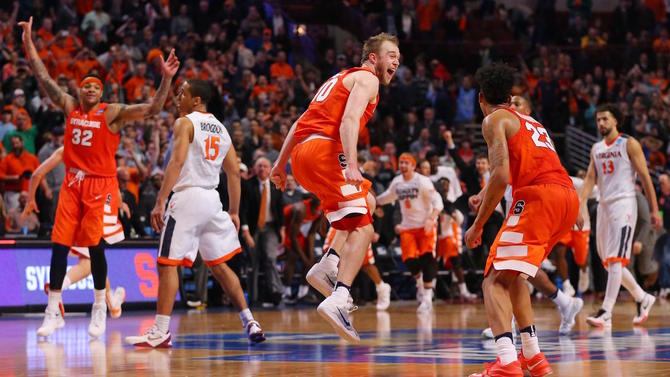
8. 2011 Butler (No. 8 seed)
The first Butler Final Four run, in 2010, was sweetly unexpected. But the next year is what established Brad Stevens as an all-time college coaching legend. Butler had bad losses that season, including a sweep by Milwaukee and, in the final loss it would take until the national championship game, falling to subpar Youngstown State. By then, Butler was 14-9 and the NCAA Tournament would only happen if the Bulldogs got the auto bid.
That happened, but remember, lottery pick Gordon Hayward was not on the 2010-11 team. Shelvin Mack, a future NBA pick, was. As were Matt Howard, Andrew Smith, Khyle Marshall and Ronald Nored.
Butler’s run began in the 8-9 game against Old Dominion. You’ll notice that a few of these Final Four runs only happened thanks to a fortuitous play at one point. Smith’s incidental tap of the ball to Howard lifted Butler to a 60-58 win.
Then Butler beat No. 1-seeded Pitt 71-70 in even more dramatic fashion. Mack brain locked and fouled Pitt’s Gilbert Brown with 1.4 to go, with Butler up one. When Brown missed his second free throw, Howard grabbed the rebound and was fouled by Nasir Robinson. Howard hit one foul shot to give Butler the upset. There never has been and never will be another sequence like it.
Stevens’ team then got by fourth-seeded Wisconsin (rated No. 6 in KenPom that season), and then toppled No. 2 Florida with an overtime win, and really, that might be the best “forgotten” Elite Eight game of the past decade. The improbable nature of the second Butler Final Four appearance is what vaults it onto this list ahead of the first.
7. 2000 Wisconsin (No. 8 seed)
I remember watching that Wisconsin team and not at all understanding Dick Bennett’s system and how UW was pulling this off. The Badgers didn’t win three straight games at any point in the regular season, but managed to win four in a row when it mattered most. In fact, at one point, on Feb. 19, the Badgers were 13-12, but this being the RPI heyday, UW wound up getting a relatively good seed because of the selection committee’s over-reliance on strength of schedule.
A Wisconsin team filled with dudes no one outside of Madison remembers (Mike Kelley, Andy Kowske, but I do remember Duany Duany!) first beat Jerry Tarkanian’s Fresno State team. Then, in the second round, Wisconsin took out one of the best teams ever to not make a Sweet 16. Arizona had Richard Jefferson, Jason Gardner, Gilbert Arenas and Luke Walton.
In the Sweet 16, Wisconsin knocked off No. 4 LSU 61-48, then beat sixth-seeded Purdue 64-60, giving Bucky a 3-1 edge over the Boilers that season. Given the lack of star power, Wisconsin not having made a Final Four since 1941 and the style of play, it’s without question one of all-time coaching masterpieces to get that team into the national semifinals.
6. 1986 LSU (No. 11 seed)
Until another team came along and did it with the same seed 20 years later, LSU was known as the anomaly. As a No. 11 seed, the Tigers broke through in the second year of the modern tournament era and made the Final Four. Although it was, and remains, a good program historically, proper perspective is needed for the improbability of that run.
That year’s LSU team was ranked in the preseason and even cracked the top 10 at one point. Then the downturn came hard. It’s hard to remember now (and I don’t; I’m going off reports from back when and records, etc.) The team had 11 losses and was a mess in SEC play, finishing 9-9. The roster included John Williams, Derrick Taylor, Nikita Wilson and Don Redden.
The reason LSU cracks the list this high: It’s the only team to ever get to the Final Four by taking out the 1, 2 and 3 seeds in its region. The quality of competition LSU faced was big-time. Ironically, LSU’s biggest issue came in the first round against No. 6 Purdue. The Tigers won in a rare tournament game that featured double overtime, 94-87. In the second round, No. 3 Memphis State -- a top-20 team -- fell 83-81.
Georgia Tech was the No. 2 seed in the Southeast that year, but LSU won 70-64 over the Yellow Jackets, the No. 1 team in the preseason, in the Sweet 16. And Kentucky was Kentucky. UK had swept LSU, having won twice in the regular season and again in the SEC Tournament. Ricky Blanton hit a layup with 17 seconds to go to give LSU its winning margin, 59-57. Dale Brown’s team won over UK because of a “freak” defense that constantly changed from man to zone.
5. 2014 UConn (No. 7 seed)
This is not the Kemba Walker team. That group, which was a No. 3 seed in 2011, was a much better overall team than the 2013-14 UConn crew that, in the eyes of plenty, is the weakest NCAA Tournament champion of this century. (But that’s a discussion for another time.)
I do think this UConn run is top-five most surprising in the modern era, though. I watched this team play in person 10 times that season. I thought a No. 7 seed, similar to South Carolina in 2017, was generous. I attended UConn’s buzzer-beating home win over Florida, which it would face in the Final Four four months later, and it was the best the Huskies looked all season. They didn’t have reliable offense beyond Shabazz Napier. But what a run this was. Napier is as beloved now, because of that 2014 title, as Walker.
And remember all those comparisons between the two? Thankfully each player stands on his own in the eyes of UConn fans these days.
As for the tourney, UConn’s toughest game was its first one. Here’s my story from that game. The Huskies were one rebound away from losing to Saint Joseph’s in the first round. But they got out with an 89-81 OT win, then breezed past No. 2 Villanova in the second round.
Connecticut got a big boost by being placed in the East Region, which sent it to Madison Square Garden for the Sweet 16 and Elite Eight. Just like South Carolina, which went through MSG, UConn was a No. 7 seed. It played a good game against No. 3 Iowa State and won 81-76. Then UConn ended fourth-seeded Michigan State (the final college games for Adreian Payne, Gary Harris and Keith Appling) with a 60-54 win. I’m even more impressed now, with three years of hindsight, than I was stunned then.
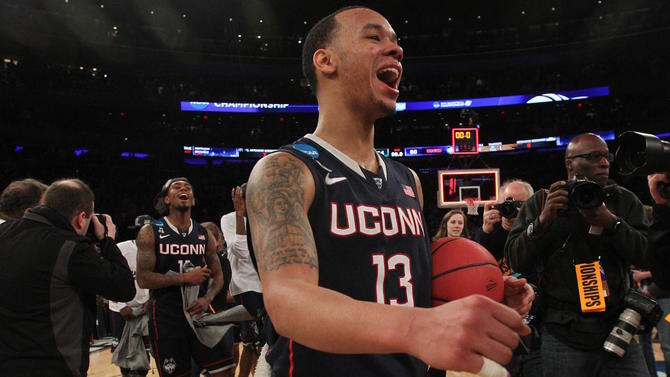
4. 2013 Wichita State (No. 9 seed)
This is the team that changed the career of Gregg Marshall and the perception of Wichita State basketball. Fred VanVleet and Ron Baker were on that team, but Cleanthony Early, Carl Hall and Malcolm Armstead were the studs of that group. Wichita State made it as an at-large after falling in the Missouri Valley Tournament to Creighton, which had Doug McDermott as a junior that season. It was Creighton’s last season in the Valley.
The Shockers had eight losses entering the NCAAs. Marshall had one NCAA Tournament win to his name before 2013. I was out there in Salt Lake City when the Shockers walloped No. 8 Pitt, winning 73-55. Also on that day: Gonzaga eeked past No. 16 Southern 64-58. So Wichita State had some buzz heading into that second-round game, and sure enough, the Shockers beat the Zags 76-70. WSU hit 14 3-pointers in that one. Wild scene. Here’s what I wrote that day. Some of Marshall’s quotes are very interesting in retrospect. That was the best Gonzaga team ever until this season’s Gonzaga team became the best Gonzaga team ever.
Wichita State caught a break in the Sweet 16 when it faced No. 11 La Salle, a team on a thrill ride and unexpected trip to the second weekend. The game was in Los Angeles, and the Shockers absolutely handled their business 72-58. Then, in the West Region final, No. 2 Ohio State went down 70-66 because the Buckeyes went 5 for 25 from 3-point range. I would have told you right then that there was no way Marshall would be in Wichita in 2017, yet he’s set up to have a top-10 team next season. Remarkable.
3. 2017 South Carolina (No. 7 seed)
It’s not that hard to frame South Carolina’s run in the moment. Yes, I think this is the third most impressive/surprising/shocking Final Four appearance of the 132 we’ve seen since 1985. The Gamecocks’ regular season was up and down, filled with irregular offense and disappointing performances against Alabama, Mississippi, Memphis and Arkansas. When South Carolina got a No. 7 seed, I said it was “weird.” And it was. Tournament performance doesn’t negate inconsistent committee decisions, but let’s move on from that for now. The fact South Carolina has done this is the coolest part. Frank Martin has a story unlike any coach that has ever made a Final Four.
The Gamecocks’ run will become famous, in part, because -- like most others on this list -- they were betting underdogs in every game. Computers have picked against them, too. But first South Carolina got past Marquette, the best 3-point shooting team in college basketball. Then the takedown of Duke, and yes, getting the games in Greenville, South Carolina, set up an interesting dynamic. Duke was favored to win the title, though, and the Gamecocks had 65 second-half points, the most ever scored in a half against a Mike Krzyzewski-coached team.
In Madison Square Garden, South Carolina twisted Baylor into refuse with a 70-50 win. And the 77-70 victory over Florida was a come-from-behind exclamation point. Sindarius Thornwell’s name will never be forgotten, and at this point his legend is on par with the great Devan Downey. Shoutout to Devan Downey. No matter what comes next, South Carolina making the Final Four after not having a tournament win in 44 years is guaranteed to be one of the two or three most memorable items from this tournament.
2. 2011 VCU (No. 11 seed)
If you want to put VCU at No. 1, you can argue the case. Unlike every other team on this list, VCU needed five wins instead of four to get there. Shaka Smart’s team, similar to the Syracuse inclusion of 2016, was chided for even making the field. The Rams -- who even after all they accomplished in the tournament finished 53rd in KenPom -- were an 11-loss team from the Colonial that dropped games to sub-100 teams three times and lost to a sub-200 team as well. Wins over UCLA, Wake Forest and Old Dominion helped VCU’s intriguing case. It barely got in.
Then it made history.
The Rams won in the first First Four by beating Southern Cal 59-46. From there, sixth-seeded Georgetown got got 74-56 (a sign of worse things to come for Georgetown). Smart’s team, which did not deploy the HAVOC defensive scheme, and in fact was more offensive-minded, suddenly got hot from 3-point range. VCU hit 10.6 3s per game on its run to Houston that year. VCU had its best offensive output of the tournament against No. 3 Purdue, winning 94-76 and ending the careers of JaJuan Johnson and E’twaun Moore.
In the Sweet 16, VCU had its close-call moment with a 72-71 overtime win against Florida State. Then, the memorable 3-point barrage against top-seeded Kansas, a 71-61 win that included nine 3-pointers in the first half. At one point VCU led by 18. What a stunner. Jamie Skeen (29 in the win over Kansas), Joey Rodriguez, Brad Burgess, Brandon Rozzell, Darius Theus. Those were the guys who pulled that off. Richmond legends.
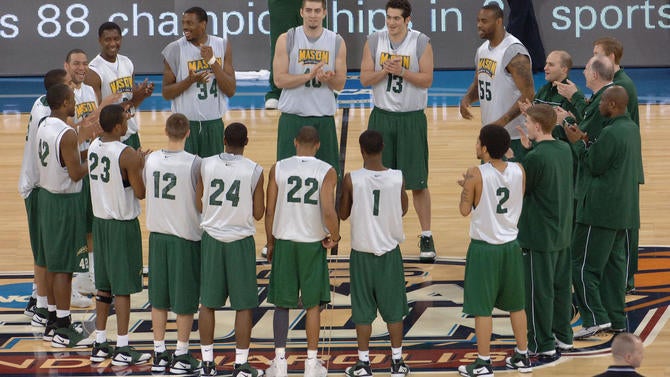
1. 2006 George Mason (No. 11 seed)
Before I get going here, let me point out: I wrote an extensively detailed story about George Mason’s barrier-breaking run. If you have not read it yet, and love the tournament, I promise that you will enjoy it.
For as long as I live I’m not sure I’ll believe Denham Brown missed that 3-pointer in overtime for UConn. In every other possible alternative universe, that ball goes in. We’re lucky to live in the one we do, because here, it did not. Here, George Mason changed college basketball history.
But before all that, Mason was fiercely debated as a team that even earned inclusion. The Patriots were swept by Hofstra, a team that didn’t get in. Funny how two CAA schools (VCU in 2011 and Mason in 2006) were subject to such harsh criticism for making the field. Don’t get the sense that would’ve happened with other mid-majors in recent years. The irony of GMU that year was how it lost to the three best teams it played in its nonconference schedule. But because the RPI was so heavily dictating committee decisions, and KenPom wasn’t even a thing discussed in mainstream media, Mason’s numbers were helped big-time by the RPI.
Jim Larranaga’s team ran through an interesting quartet. First, Tom Izzo’s sixth-seeded Spartans. A confident 75-65 win. That was on a Friday, and it made for a fun first round. Then on Sunday, surely, North Carolina -- the reigning national champ -- would end it. But no. The Tar Heels go down 65-60, and helped in part by the fact GMU assistant Scott Cherry was a UNC alum who understood Roy Williams’ scheme.
In the Sweet 16, a mid-major rematch. The only reason Mason made the tournament was because it won at Wichita State on Feb. 18 of that year, 70-67 in the closing seconds. The Shockers were a strong No. 7 seed but didn’t look it that Friday night. George Mason -- which had never even won a tournament game before 2006 -- was in the Elite Eight after defeating the Shockers 63-55.
Then the UConn game. Top-seeded Huskies. The most talented team in the field, the favorite to win it all. Remember, Mason lucked into having that regional in the East, right there in Washington, D.C., and not that far from campus. GMU had more supporters in the building than Connecticut. The Patriots won 86-84 in overtime in what is, I think, one of the 10 best tournament games in history. Huge plays for both sides, end-to-end drama. Best of all: Verne Lundquist and Bill Raftery on the call.
George Mason is the best Final Four Cinderella story ever because the team didn’t have a star, had no NCAA Tournament history, beat blue-blood programs, three Hall of Fame coaches and took down the prohibitive title favorite to become the first true mid-major program to win four games and go to the sport’s ultimate stage.












